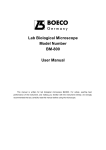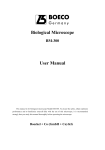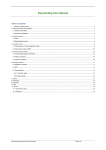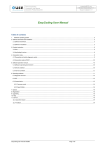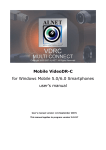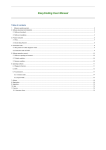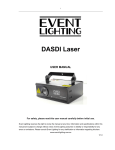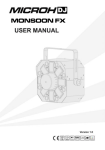Download Biological Microscope BMS C1 series User Manual
Transcript
Biological Microscope BMS C1 series User Manual This manual is written for biological microscope BMS C1. For safety, exerting best performance of the instrument, and making you familiar with the instrument entirely, we strongly recommended that you carefully read this manual before using the microscope. Contents BMS C1 Use Notices …………………………………………… 1 ………………………………………………………… 2 1 Name of Components 2 Installation 2.1 Installing Illustration………………………………………………………… 2 2.2 Installing Steps ……………………………………………………………… 3 3 Adjustment & Operation …………………………………………… ………………………………… 7 ……………………………………………………………… 9 3.1 Adjustment System Installing Illustration 3.2 Operation 7 4 Technical Specifications …………………………………………… 12 5 Configuration Table ………………………………………………… 13 6 Trouble Shooting …………………………………………………… 13 Use Notices BMS C1 I、Safety note 1. Carefully open the box, avoid the accessories, like lens, dropping to ground and being damaged. 2. Do keep the instrument out of direct sunlight, high temperature or humidity, dusty and easy shaking environment. Make sure the stage is smooth, horizontal and firm enough. 3. When moving the instrument, please use two hands to grip with the two sides of the microscope body. 4. If the bacterium solution or the water splash to the stage, objective or viewing tube, pull out the power cord at once, and wipe up the microscope. Otherwise, the instrument will be damaged. 5. When running, the lamp house and nearby parts will be very hot. Please ensure there is enough cooling room for them. 6. Make sure the instrument is earthed, to avoid lighting strike. 7. For safety, be sure the main switch is in “O”(off) state before replace the halogen lamp or the fuse, then cut off the power, and do the operation after the lamp bulb and the lamp house completely cool. 8. Check the input voltage: be sure the input voltage which signed in the back of the microscope is consistent with the power supply voltage, or it will bring a serious damage to the instrument. 9. Use the factory supplied power cord, please. II、Maintenance 1. All the lenses have been well checked and adjusted. It is forbidden to disassemble them yourself. 2. The nosepiece and coarse/fine focus unit have a compact and precise frame, please don’t disassemble them as possible as you can. 3. Keep the instrument clean, wipe dust regularly, and be attention to avoid contaminating the optical elements especially. 4. The contaminations on the prism, as finger mark and oil, could be gently wiped with a piece of soft cloth or tissue paper, gauze which has been immersed in pure alcohol or xylene. (note that the alcohol and the xylene are all burned easily, do not let them near the fire, and use them in a drafty room as possible as you can.) 5. Don’t use organic solvent to wipe the non-optical elements, when you need to clean, use the soft detergent, please. 6. When using, if the microscope is splash by liquid, cut off the power at once, and wipe up the moisture. 7. Do not disassemble any parts of the microscope. That will affect the function or decline the performance of the microscope. 8. Place the instrument in a cool, dry position. After using the microscope, remember to cover it with dust helmet. Do wait for the lamp house cooling completely before cover. 1. NAME OF SPARE Eyepiece BMS C1 PARTS Binocular viewing head bino Nosepiece Objective objective Body 1 2. 2.1 Installation BMS C1 Installing Illustration The following shows the installing order of the spare parts. The number express the installing process. before the installing ,make sure there is no dust and stain on the spare parts . No marks by outside force on the surface of the spare parts or glass . Keeping the hexagon- spanner well , when change the spare parts , you will use it . Binocular Viewing Head 10x Objective ② ① ③ ④ Objective Body Cable Wire 2 BMS C1 2. Installing Setps 2.2.1 Install the binocular viewing head (picture No 1-2) Insert the binocular viewing head in the head of the body , turn to the right place ,then fix up it by bolts. Picture 1 2.2.2 Install the eyepiece Picture 2 (picture No.3-4) Insert the eyepiece in the eyepiece tube till end. No.4 picture shows the station after the installing . Picture 3 Picture 4 3 BMS C1 2.2.3 2.2.3 install the objective (picture No.5-6) 1: Adjust the coarse & fine focus knob, till the mechanical stage to the low limited place. Picture 5 2. Screw down the objective to nosepiece one by one. Clean the objective frequently. At first, use the 10X objective to looking for image, then change another one. Picture 6 Turn the objective till hear the “kaca” sound, make sure the objective enter the objective center. 2.2.4 Picture 7 Install the filter (picture 7) 1. Swing out the condenser holder① 2. Put the filter in the holder. Then swing the holder in. 4 BMS C1 2.2.5 Link cable wire (picture NO.8-9-10 ) ★ Do not push strong force on the cable wire because the bending cable is easily be destroyed. 1. Before linking the cable, make sure the switch① is cut off. 2 Insert the electronic plug ② Picture 8 in the socket ③ safely . 3: Insert ④ on ⑤ . ★ Use the cable wire supplied by BMS company. when destroyed make the choice of same type. ★ The machine adopt the wide voltage, can work under the voltage of 230V/50Hz. Picture 9 2.2.6 change the fuse (picture9&10) Before change the fuse, make sure that the switch ① is cut off, swing out the ⑥,change new fuse, then swing back into the ⑦. Picture 10 5 BMS C1 2.2.8 install & change ( picture 11、12、13) the lamp Please use the designated 6V/20w halogen lamp. 1:Pull out the condenser set ①. 1. Use the pledge wrap the lamp ①, put the lamp pin into the socket ③. Picture 11 2. Change the lamp during usage. Make sure the switch is cut off & all parts around lamp are cool down. Insert the lamp carefully, do not touch the lamp with finger &strong force. Insert the condenser opposite direction as picture . picture 12 Picture 13 6 3. adjustment &operation BMS C1 3.1 adjustment system installing illustration (picture No.14-15) interpupillary showing distance condenser adjustment knob Eye viewing adjust ring locking knob left fine focus knob left coarse focus knob light adjusting switch Picture 14 7 BMS C1 Aperture Diaphragm Lever Right Fine Focus Knob Portrait Adjustment Knob Right Coarse Focus Knob Main Switch Lateral Adjustment Knob Tension Adjustment Collar 15 8 BMS C1 3.2 Operation 3.2.1 Adjusting the Illumination (Fig.20,21) 1. Connect the power, turn on the main switch (figure 15) to “-”(on). 2. Turning the brightness adjustment knob anti-clockwise, the voltage raise, and the brightness strengthen; turning it clockwise, the voltage decline, and the brightness weaken. Fig.20 Using the lamp in a low voltage condition, will prolong the use life. 3.3.2 Placing Specimen (Fig.22) 1. Place the slide on the mechanical stage. Use the stage clips to clamp the slide gently. 2. Turn the portrait and lateral adjustment knob of the mechanical ruler, move the specimen onto the required position. Fig.21 Be careful when changing the objective. If you finish the observation with the short working distance objective, and want to change another one, be careful of not letting the objective touch the specimen. 3.3.3 Focusing (Fig.23) 1、Use the 10×objective focus, to avoid the objective touch with the specimen, you should raise the mechanical stage at first, let the specimen close to the objective, then slowly separating Fig.22 them to focus. The operator can converse turn the coarse focus knob① to get the specimen down ,and search images in the 10×ocular simultaneously, then use the fine knob② to focus. At this moment, you can replace other magnification objectives safely, and focus without the risk of destroying the specimen. If you need to fix the stage on a vertical position to make the observation become more convenience, take use of the locking set. Fig.23 9 BMS C1 3.3.4 Adjusting the Condenser(Fig.24) Turn the condenser focus knob to shift the condenser. It needs to raise the condenser when using the high magnification objective, and to decline when using the low magnification one. Fig.24 The center of the condenser and the light axes of the objective are coaxial. It has been adjusted before leaving factory, so the user needn’t to adjust them by self. The highest position of the condenser has been adjusted too. It also needn’t any user’s operation. 3.3.5 Adjusting (Fig.25) the Aperture Diaphragm Turn the Aperture Diaphragm Lever①,to adjust the aperture size. Fig.25 Aperture Diaphragm is designed for adjusting the aperture size, not for adjusting brightness. Generally, reducing the diaphragm opening to 70- 80% of the N.A. value of the respective objective will provide an image of acceptable quality. If you want to observe the image of the aperture diaphragm, remove one eyepiece and look through the tube. You will see a dark circle encroaching on the bottom of the tube. 3.3.6 Adjusting the Interpupillar Distance (Fig.26) The interpupillar distance range:55mm~75mm. When observing with two eyes, hold on the left and right prism holder, turn around the axis, adjust the interpupillar distance until the left and right fields of view coincide completely. Fig.26 10 BMS C1 3.3.3 Adjusting the Diopter(Fig.27) 1. Observe the right ocular tube with your right eye. Turn the Coarse & Fine Focus Knob to focus the specimen. Observe the left ocular tube with your left eye. If not in focus just adjust the Diopter Ring① to make it in focus. ★ the range of Diopter Ring is ±5, as the value align the reticle② of the ring. 图 27 3.3.9 Adjusting Collar(Fig.28) the Tension Adjustment The tightness of the tension adjustment collar has adjusted before leaving factory, if finding it’s loosing (the mechanical stage drop itself because of deadweight), please turning the tension adjustment collar① until the tightness is in order. Turn it along the direction show in the picture, the Coarse Focus Knob② will become tighter. Turn anti-direction will become loosen. If the mechanical stage drop itself, or even lose focus just after adjusting the fine focus knob③. Mean the tightness of the Coarse Focus Knob② is too low. You should turn the tension adjustment collar along the direction show in the picture to make it tighter. Fig.28 11 4.Technical Specifications BMS C1 一、Main specifications Mechanism Length Tube 160mm Viewing Head Compensation Free Head, Inclined at 30, Interpupillar distance: 55-75mm Eyepiece View field line 18mm Nosepiece Forward Quadruple Nosepiece Objective Achromatic :4×,10×,40×、100× Focus System Coaxial Coarse and Fine Focusing System, Sensitivity and Graduation of Fine Focus: 0.002mm. Coarse & fine focus range:23mm Condenser Abel, NA=1.25 Stage Double layer mechanical stage, area: 140×140mm, movement range: 75×50mm Lamp-House halogen lamp 6V/20W Eyepiece & Objective 1. Objective Magnification Numerical Value Aperture Diaphragm(N.A) Thickness of Cover Slip(mm) Focus(mm) 4× 0.10 0.17 31.05 37.5 Dry 10× 0.25 0.17 17.13 7.316 Dry 40× 0.65 0.17 4.65 0.632 Dry 100× 1.25 0.17 2.906 0.198 Oil Working Working Distance(mm) Mode 2. Eyepiece Sort Magnification Focus(mm) View field line(mm) Plan Eyepiece 10× 24.95 Ø18 3. Total magnification with Objective plus Eyepiece: Objective 10× 10× 10× 10× Eyepiece 4× 10× 40× 100× Total magnification 40× 100× 400× 1000× 12 5.Configuration table BMS C1 Standard Name of Specifications Amount Equipped Components Main Frame 1 〇 Double Layer Mechanical Stage 1 〇 Condenser Bracket 1 〇 Observation System Compensation Free binocular Head 1 〇 Condenser N=1.25 Abbe Condenser 1 〇 Nosepiece Quadruple Nosepiece 1 〇 6V/20W Halogen Lamp 1 〇 Spare Lamp 2 〇 Spare Fuse BGX-1-20(0.5A) 2 〇/2 Plan Eyepiece 10× 2 〇 Achromatic Objective 4× 1 〇 Achromatic Objective 10× 1 〇 Achromatic Objective 40× 1 〇 Achromatic Objective 100×(Oil, Spring ) 1 〇 Condenser Bright Field Condenser with Changeable Raster 1 〇 Filter Baby Blue ,Green 1 〇 Body Lamp-house Eyepiece Objective 13 6.Trouble Shooting BMS C1 I. Optical Part: PROBLEMS 1. The edge of the field of view has shadow or the brightness is asymmetry 2. Stains in View Field 3. Low image quality (Low resolution, low contrast) 4. One side of image is dark. REASON FOR PROBLEMS SOLUTION The nosepiece is not in the located position Adjust it position into the located The filament Imaging not in center Adjusting it to center Stains on the lens (Condenser, Objective, Eyepiece) Wipe up Stains on the lens (Condenser, Objective, Eyepiece) Wipe up Stains on the specimen Wipe up The Condenser position is too low. Loose the condenser locking bolt. Adjust the position of condenser. Screw down the locking bolt. No cover slip on the specimen Cover the slip The cover slip is too thick or too thin. Use standard cover slip.Thickness:0.17mm The specimen is reversed Reverse back. The dry objective is stained with oil (Especially 40X) Wipe up Stains on the lens (Condenser, Objective, Eyepiece) Wipe up The oil objective is not in oil. Use oil There is air bubble in oil Remove oil Not use the appointed oil Use the appointed oil The opening of Aperture diaphragm is too large Properly make it smaller Stains on the incidence lens in the binocular drawtube. Wipe up The opening of Aperture diaphragm is too small Properly make it larger Condenser position is too low Adjust the position The condenser is not in center of the view field, or the condenser is inclined. Reinstall the condenser and adjust the center carefully by using the condenser adjusting bolt. The nosepiece is not in the located position Turn it into the required position The specimen is floating on the stage. Reinforce it reliably. 5. The image moved when focusing. 6. The image takes the yellow slightly. 7. The bright degree is not enough The specimen is floating on the stage. Reinforce it reliably. The nosepiece is not in the located position Turn it into the required position Not use the color filter. Use the blue filter. The opening of Aperture diaphragm is too small Properly make it larger Condenser position is too low Adjust the position Stains on the lens (Condenser, Objective, Eyepiece) Wipe up 14 BMS C1 II. Mechanical Part: PROBLEM REASON FOR PROBLEM SOLUTION 1. Can’t focus when use high magnification objective. Slice put reversed. Cover slice is too thick. Reverse back Using standard cover slice. Thickness: 0.17 mm 2. Touch the slice when switch the objective from low magnification to high one. Slice put reversed. Cover slice is too thick. Reverse back Using standard cover slice. Thickness: 0.17 mm 3. The specimen move not flowing The slice holder not nip the slice firmly. Make it firmly 4. Two eyes image not in superposition The interpupillar distance is not correct Adjust the interpupillar distance correctly The diopter is not right Adjust the diopter according your sight 5. The eyes uncomfortable are 6. The bright degree is not properly Adjust the voltage of bulb. III. Electric Part: PROBLEM REASON FOR PROBLEM SOLUTION No power supply Check the power cord, and connect them exactly the installation of the bulb is wrong Install the bulb correctly The bulb burn out Change a new bulb 2. The bulb burn out in a high frequency Not use a appointed lamp High voltage Use a appointed lamp. If the circumstance still not change, please contact the maintenance part. 3. The rightness degree is not enough Not use a appointed lamp Low voltage use a appointed lamp Turn up the voltage 1. The lamp light can’t 4. The light glimpse The bulb is going to spoil Change the bulb The power cord have a poor contact Check the power cord, and connect them exactly




















